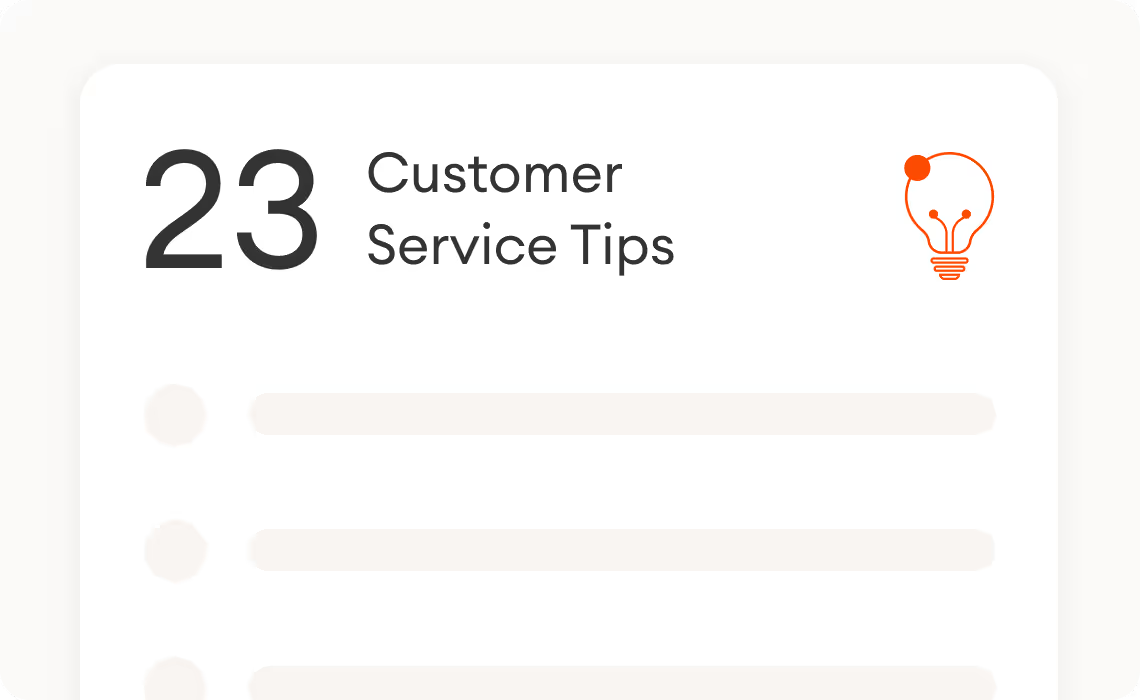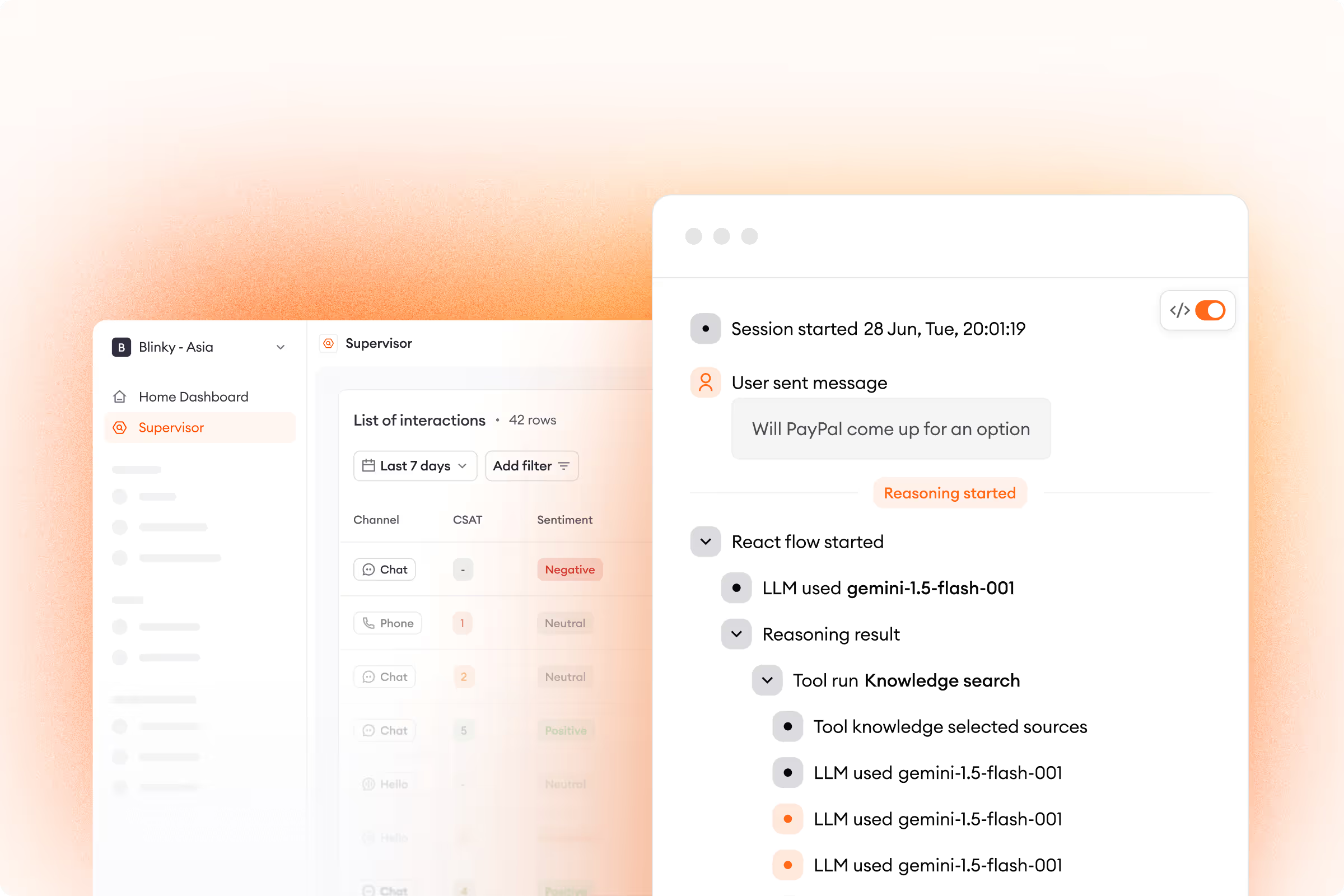Providing excellent customer service is tough.
Rising customer expectations, resource constraints, and complex situations are only a few of agents' day-to-day challenges.
To help teams better navigate these challenges, we asked Zowie’s team of customer success specialists to share their proven tips for delivering an exceptional customer experience.
Here’s what our team had to say on:
- Building customer relationships
- Sharpening your customer service skills
- Professional development
- Applying tools
23 customer service tips to make your team more effective
On building customer relationships
1. Show empathy
For many issues, providing support is all about understanding a customer’s needs and connecting with them on a human level. More often than not, this means empathizing with them, putting yourself in their shoes, and remembering to treat them like a human — not just a number.
Displaying empathy can help you form stronger connections with customers, boosting customer loyalty and satisfaction in the process.
2. Repeat what customers say
In the fast-paced world of customer support, it’s all too easy to misunderstand what a shopper is asking for. If you don’t know what a customer needs, your interactions will only lead to more frustrated consumers and wasted time — for them and yourself.
A simple way to ensure you’re on the same page is to repeat their issues as you understand them. This’ll help avoid confusion and demonstrate that you’re actually listening and trying to get to the root of the customer’s problem.
3. Address customers by their name
Customer support reps should start off every conversation by providing a warm greeting, introducing themselves, and asking for the customer’s name. This establishes a human connection from the get-go and helps shoppers feel they’re getting more personal service.
Sprinkling your responses with comments like What can I do for you, Stacy? and Did that resolve your issue, Doug? conveys that you’re handling tickets with the greatest care, leading to a more pleasant customer experience.
4. Ask customers questions
Another way to highlight you’re paying attention is to ask follow-up questions. Productive conversations are rarely a one-way street. For true progress, you need a back-and-forth discussion.
Asking questions also helps customers feel appreciated. It starts with a simple How are you doing? but it goes much further than that. Asking the right questions allows you to identify their issue and pinpoint what they feel the appropriate solution should be.
5. Use positive language
If you can’t deliver 100% of what a customer is asking for, you should steer clear of negative language. Remove words like can’t, don’t, and not from your vocabulary and replace them with positive statements. These convey the same message but are much more likely to leave you with happy customers.
For instance, swap a negative response like I’m sorry, you won’t receive your refund until next month with a positive statement like Your refund will be ready next month. We’ll notify you as soon as it’s sent.
6. Encourage customer feedback
Just because an issue is resolved doesn’t mean your conversation is over. An effective way to conclude chats is to collect feedback about the customer service experience.
Better yet, designate a number of predetermined touchpoints throughout the customer journey for feedback collection. What do shoppers have to say about your products, your checkout process, and the post-sales support you provide? Giving customers a channel to express their feedback won’t just make them feel more valued — it’ll show your entire customer service team precisely what you’re doing right and what needs improvement.
See just how much businesses can gain from customer feedback in our blog post, What Is Customer Sentiment and Why Is It So Important?
On sharpening your customer service skills
7. Be patient
Even when customer service agents have mountains of tickets to get through, some customers just like to talk. For other cases, finding a solution can require a fair amount of time. Whatever kind of tickets you handle, exercising patience will set you up for success.
Hear your customers out, and let the conversation progress at their speed — don’t make them feel rushed. Likewise, thank customers for their patience any time they need to wait.
And by the way — the benchmark for average handle time over live chat is 10 minutes. You should have plenty of time to talk things through with shoppers without worrying about your metrics.
8. Be consistent
As a customer service representative, your mood and productivity likely won’t be the same on Monday morning as on Friday afternoon. But whether you’re handling your first or twenty-first support ticket of the day, it’s important to deliver consistent responses to all of your customers.
Whenever you’re tired or in a funk, take a moment for yourself — inhale, have a sip of water, or get a quick stretch in. Remember, for every customer who comes to you for support, you’re the face of the company. Treat each chat like a high-priority conversation to ensure every shopper gets the best customer service possible.
9. Stay calm
Handling customer complaints is challenging. After all, we’re only human. But when you’re interacting with frustrated customers, staying calm is essential if you want a positive outcome.
In fact, calmly working out an issue with a customer can transform a poor customer experience into an excellent one. Knowing how to defuse a tense situation is a valuable communication skill that shouldn’t be neglected. Acknowledge the customer’s feelings, speak softly, and understand their expectations. Then, it’s much easier to guide shoppers through a solution step by step.
10. Respond quickly
57% of customers say long wait times are the most frustrating thing about customer service. Avoid this common pain point by responding to your tickets as quickly as possible.
And this doesn’t mean you have to hastily resolve an issue before you can reply. Even a helpful Let me see what I can do is better than silence, as it reassures shoppers that they’ve already gotten through to an agent.
11. Take notes
Sometimes, customers share lots of information with support agents, and focusing on the issue at hand can get tricky. To make your job easier, take internal notes as you’re chatting with shoppers. Briefly record the specifics of a case — the roadblock, goal, and necessary context — to plan out your next steps.
Taking notes also gives fellow agents much-needed support. If a ticket ever gets transferred to another rep, they’ll have an outline of the case, including the most pressing action points, clearly laid out in front of them.
12. Create post-ticket workflows
Even after customer issues get resolved, keeping up with shoppers is an effective way to show them you’re willing to go the extra mile to ensure they’re still enjoying a positive experience. You can trigger all kinds of workflows after a ticket is closed to show shoppers you’re available for further communication.
For example, if you help a customer with an order, send them a follow-up email after delivery asking How are the new sneakers? To really make them feel valued and extend the customer journey, throw in a special deal, like I hope everything’s OK with your order. By the way, here’s an exclusive 15% discount for your next purchase with us.
13. Personalize responses
Speed in customer support is key, but achieving efficiency doesn’t mean sacrificing the human touch. Review a shopper’s chat history or past purchases to offer advice or recommend products that are relevant to them.
Free yourself from any restrictive script and talk to customers like an individual. Build up a rapport with them to strengthen your relationship. If appropriate, consider adding jokes, emojis, or informal language so each customer feels they’re getting a real conversation.
Find out how else companies can personalize their customer service — and the benefits personalization yields — in our What Is Personalized Customer Service? blog post.
On professional development
14. Be solution-oriented
At the onset of every customer interaction, bear in mind that your goal is to find a solution for the customer. Filter out any emotions, digressions, or distractions that may get in the way, and zero in on answering this question: how can I solve this customer’s issue?
Focusing on a solution can improve your resolution times and elicit positive reactions from customers. Shoppers will notice that you’re trying your hardest to assist them, and that goes a long way in building customer retention.
15. Practice active listening
According to Shopify, 70% of buying experiences are based on how a customer feels they’re being treated. If customers think they’re being ignored, you’ve got a major problem on your hands. Prevent this risk by practicing active listening and showing that a customer has your undivided attention.
Don’t limit yourself to replying with solutions and nothing else. Proactively give reaffirming statements like I see how that’s a problem underscore to shoppers that they have your attention and you’re on their side.
16. End conversations the right way
Just because you’ve offered a customer a potential solution doesn’t mean you get to close the ticket and move on to the next one. Abruptly ending a conversation without confirming that a customer is satisfied will irritate shoppers — especially if you didn’t resolve their complaint.
Instead, make the following question part of your routine. Once you provide help, ask Is there anything else you need help with today? This makes it crystal clear that you’re determined to get to the bottom of any problem and are willing to keep working until an acceptable solution is found.
17. Keep your team happy
Even though customer support revolves around one-on-one interactions between an agent and a shopper, it’s still a team sport. The customers that come your way might be happy, but if the agent sitting next to you is struggling, your whole organization will suffer.
The best support reps are those who collaborate with their peers. That’s why it’s imperative to make sure each team member has the resources needed to deliver great customer service. Give each other positive reinforcement and constructive feedback that can help with the next call. Furthermore, consider holding internal training sessions if there’s a topic or area many people struggle with.
18. Commit to lifelong learning
Good customer service isn’t a one-time achievement you’ll always possess once unlocked. Staying at the top of your game requires continuous learning and development. Regularly refine your communication, people, and problem-solving skills, enroll in courses (either free or paid), and talk with someone you respect. Your business and customer needs are always evolving, so approach each day as a learning experience.
In addition, existing tools can unveil new features capable of drastically altering the customer service landscape in the blink of an eye. Stay informed on the latest topics involving tech, customer care, and your business to continue giving exceptional customer service.
To explore AI’s transformational impact on customer service today, check out our insightful ebook, An Introduction to AI in Customer Service.
Applying tools
19. Add templates
Many customer questions are repetitive, and spending your valuable time and energy on each one can be an inefficient use of your resources. Build templates for your most common issues and deploy them to address your top customer concerns even faster.
Yes, you’ll save time, but customers will also see benefits in the form of quicker responses. Answering FAQs like where’s my order? It doesn’t require your specialist knowledge, so don’t let it take up too much time.
Zowie Chatbot’s 75 ready-to-use scenarios enable teams to build automated templates without any manual training. Discover more here.
20. Monitor performance metrics
Sure, you might feel like you’re handling support tickets effectively, but you’ve got to track your support metrics to accurately see how well you — and the rest of your team — are performing.
Are your first response times and resolution times in line with your KPIs? And what about your CSAT scores — are your customers really satisfied? Monitoring your metrics is your best bet to delivering support that’s positively impacting your business as a whole.
Take a deep dive into the most important customer service metrics — and how to improve them — with our Top 19 Customer Support Metrics to Measure blog post.
21. Create an internal knowledge base
You might not be able to come up with the answer to every customer question immediately. But with a robust knowledge base at your fingertips, finding the right answer becomes much easier. If you don’t have a knowledge base that’s easy to search and use, build one. Doing this will help existing agents and speed up onboarding for new ones.
Support reps are also uniquely positioned to hear customer pain points first-hand, meaning they know which resources their organization may be lacking. Agents can craft — or contribute to — tutorials or how-to guides, making it easier to guide customers to the best answer each time.
22. Offer self-service options
To provide optimal service, agents can leverage their knowledge base as the foundation for other self-service options, like FAQ pages or a chatbot. By empowering customers to handle more issues on their own, you’ll help them find information faster and provide yourself relief in the form of fewer support tickets.
67% of customers prefer self-service options over contacting a customer service rep, so embracing these service channels is key to meeting customer expectations as well.

23. Have the right software
To unleash your maximum potential, you’ve got to have the right solutions by your side. For instance, today’s top chatbots can fully resolve up to 70% of customer questions without a human agent, but not every tool can achieve such levels.
Using an all-in-one inbox is just as crucial, as it makes it much easier to personalize chats, streamline workflows, and deliver immediate responses.
Zowie — made with agents in mind
We believe these expert tips can help anyone be a better customer service representative, but delivering exceptional support day in and day out is no small feat.
That’s why we wanted our customer service suite to do more than automate questions — we designed it to help support agents realize their full potential.
Zowie is the only customer service automation software built for teams looking to maximize their efficiency and unlock their revenue-generating capabilities.

.avif)

.avif)
.svg)







